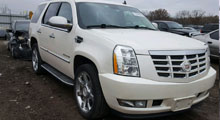Where Auction Cars Come From
Buying a used car can often be stressful and intimidating, especially if you’ve never done it before. When it comes to buying second-hand vehicles, you’ve got a few options. You can buy from an individual and risk getting a lemon, you can go through a dealership and buy a decent car but pay a premium price, or you can go down an entirely different route and visit a vehicle auction.
Auctions are a great way of buying amazing used cars at extremely affordable prices, but if you’re not careful you may end up with someone else’s mess. In this article, I want to delve deeper into vehicle auctions. More specifically, I want to talk about where vehicle auction cars come from so that you get a better understanding of how auctions function and why they’re absolutely amazing in my opinion.
Public auctions
If you attend a local auction or even an online one, chances are you’re buying a vehicle directly advertised by its current owner. The way these auctions works is rather straightforward. Anyone can sign up for an auction and advertise their car through the auction house. Bidders can then bid on the car, and the winning bid gets to keep it. The original owner of the car gets most of the proceeds of the auction, with the auction house retaining a small sum as a fee for their services. If an owner doesn’t want to sell his car for what he deems a below trade-in value, he can set a reserve. Unless that reserve is met or surpassed, the car doesn’t get sold.
With this auction model, the auction house doesn’t own any of the vehicles. The owners do. The auction house is merely an intermediary, acting as the middle-man between the seller and the buyer. They charge a small fee for doing so, and they’re usually more than happy to take care of all the necessary and associated paperwork. Most public auctions function this way, but because you’re buying from a third-party individual, your chances of buying a lemon are rather high, especially if you’re buying something damaged with the intent to fix it and turn it around for profit.
Government auctions
Government auctions are gaining more and more popularity these days, but as people are starting to realize this, competition is quickly becoming rather fierce. One of the big questions regarding government actions people seem to have is this: “Where do government vehicles even come from?”
In an effort to answer this question and help you out, here’s a list with some of the most common ways government auctions acquire inventory.
1. Seized vehicles
Seized cars seem to be the most sought after vehicles at any government auctions, and it’s not difficult to see why. Most seized cars are/have been related to a crime, usually involving drug trafficking or money laundering. In the US, as well as many other countries around the world, defense agencies and the judiciary system have the right to seize assets from physical persons or business entities believed to be engaged in illegal activities. This process, also known as civil forfeiture, can be filed against an asset (such as real estate and vehicles).
Once the government seizes an asset, in this case a vehicle, they can then decide to sell it in order to recoup some of the worth believed to be lost through the individual’s illegal activities. Money raised from selling these cars goes straight back into government budgets.
For car buyers, seized cars represent amazing value for money because their previous owner probably took good care of them. A lot of these seized car lots are large SUVs and luxury sedans, so if you’re in the market for a high-end vehicle, definitely check out your next local government auction.
2. Surplus
Believe it or not, the government has a ton of surplus vehicles. This could be because they ordered too many cars before they decided to disband their current fleet, or because they’re experiencing budget cuts and need to get rid of a few. Most surplus cars sold through government auctions are in amazing shape, and the government is only deciding to get rid of them to avoid further depreciation and maintenance costs associated with the vehicles.
3. Related Institutions
Other institutions, such as hospitals and schools, can decide to auction off vehicles through a government auction. This usually only applies to cars purchased through a government contract, but needless to say, if you want a school bus or an old ambulance, what better way than purchasing one directly from the institutions which used them?
4. Off-lease
Here’s a little known fact for you: the government often buys and leases vehicles to other agencies. The institution responsible for the acquisition and setting up the lease is called the General Services Administration (GSA). When the lease is done, the agency which leased the vehicle returns it to the GSA, at which point the GSA can decide to auction these cars off and update their fleet with more modern vehicles.
Conclusion
As you can probably see, buying a vehicle through a government auction makes a ton of sense. Not only are you getting used cars which have been properly maintained and looked after their entire lives, but you’re also buying vehicles which have a story to tell. Imagine how cool it would be to own a Dodge Charger that’s been previously used as a highway patrol car, and has probably been involved in at least one high-speed chase throughout its life? Now that sounds like a good story you’d be able to tell your friends and family.





